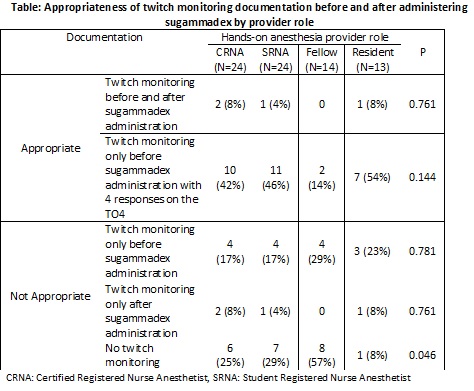OS2-148
Monitoring documentation of sugammadex use at a large tertiary care pediatric hospital
Trifa M, Syed F, Tunim D, Tobias J, Uffman J
Nationwide Children's Hospital, Columbus, Ohio, United states
Background: Sugammadex is a novel pharmacologic agent approved for clinical use in December 2015 by the United States FDA. It reverses neuromuscular blockade (NMB) via encapsulating the muscle relaxant (rocuronium or vecuronium), rendering it unavailable at the neuromuscular junction. Dosing is based on the degree of NMB (train of four [TO4] monitoring) at the time of reversal. Review of our institution’s documentation revealed that TO4 assessment prior to sugammadex administration was less common than anticipated, resulting in deviation from the manufacturer’s dosing recommendations. The primary purpose of this study was to improve documentation of TO4 and secondarily to ensure the correct sugammadex dosing by anesthesia providers in a large tertiary care pediatric hospital.
Methods: We reviewed charts of patients >1 year of age in whom the NMB was reversed by sugammadex. MRI cases, cases staffed by an attending anesthesiologist alone, and cases staffed by the project investigators were excluded. Documentation of TO4 before and after sugammadex administration as well as the sugammadex dose were assessed. Patients with 4 twitches before NMB reversal did not require further TO4 documentation. After obtaining these baseline data on compliance, provider level compliance was shared and departmental level education regarding assessment and proper dosing regimens were provided. Post-intervention chart review was then undertaken.
Results: One hundred cases were reviewed as baseline data and 75 cases were reviewed after interventions were completed. Prior to interventions, TO4 documentation was correct in 30 of 100 cases, and this proportion improved after intervention to 34 of 75 (45%; p=0.024). After intervention, reasons for incorrect TO4 documentation included missing TO4 before sugammadex administration (n=26) and <4 twitches documented before sugammadex administration with no subsequent TO4 documentation (n=15). However, there were no differences in appropriateness of TO4 documentation by provider role (Table). Among 49 cases where TO4 was documented before sugammadex administration, the dosing was correct in only 25 cases (51%), compared to 34 of 40 (85%) cases reviewed before intervention (p=0.001). Among post-intervention cases with TO4 documented before sugammadex administration, sugammadex was over-dosed (>110% of recommended) in 11 cases, but under-dosed (<90% of recommended) only in 2 cases.
Conclusion: Despite increased use of TO4 monitoring, the percentage remained low (45%) after educational interventions suggesting the need for other forms of interventions such as decision support for the electronic health record. The dosing of sugammadex remained variable and was considered correct based on TO4 monitoring in only 51% of patients. Excessive dosing was the most common error with only 2 of 49 patients receiving a dose <90% of the manufacturers recommendation based on degree of neuromuscular blockade.
Top












